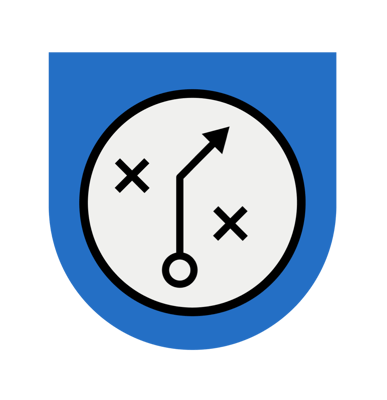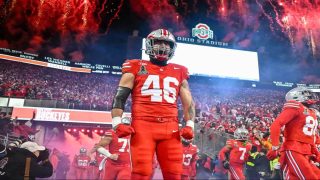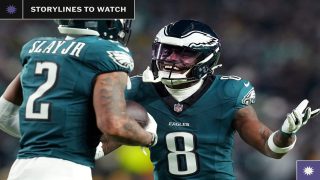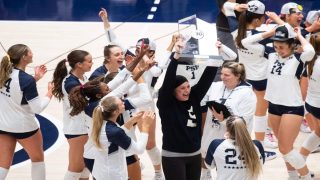The San Francisco 49ers narrowly beat the Tampa Bay Buccaneers in a game that had no business being as close as it was. Tom Brady, who was on the broadcast, brought up an interesting criticism of the 49ers offense that shows up at the worst times.
How did Ja’Marr Chase get so open against the Baltimore Ravens when he’s the Cincinnati Bengals’ most obvious weapon?
Defensive coordinator Steve Spagnuolo and his defense came up big against the Denver Broncos when the Kansas City Chiefs needed it most.
We’ll break all this down in Week 10’s best and worst coaching calls.
49ers vs. the blitz
I’m highlighting a very small weak point for the 49ers that hardly affects the offense overall but does affect it against heavy-pressure defenses and often at critical junctures of the game.
Coach Kyle Shanahan doesn’t want his quarterbacks bogged down with protections and constantly worrying about getting into the perfect protection. He has answers built into his passing concepts for the quarterback in case of blitzes called “hot routes.” They’re simply short routes the quarterback can go to when there’s a blitz the offensive line can’t pick up.
Quarterback Brock Purdy is great at identifying pressures and finding his hot routes, making him a great fit for the system. Against the Buccaneers, Purdy was 12-for-14 for 200 yards with one touchdown against the blitz. Purdy will sometimes ignore his hot route and wait for a route to develop if he thinks he can get the ball off before the free rusher gets to him — he’s been doing that more this season.
8:58 in the third quarter, third-and-5

Here, the 49ers had six potential blockers against six potential rushers at the line of scrimmage. However, running back Christian McCaffrey would release into a route, so the Buccaneers brought one more than the 49ers could block to Purdy’s right.

Purdy knew he had to deal with a free rusher, but instead of throwing quickly to his hot route, which looked to be George Kittle running a speed out outside, he drifted away from the pressure. He waited for Deebo Samuel to break open and threw to him for a first down. This approach mostly works for the 49ers, but there are times when it can work against them.
13:06 remaining in the fourth quarter, third-and-9

Later in the game, down by 4 points in the fourth quarter, the 49ers faced a third-and-9 from the Buccaneers’ 36-yard line. Predictably, Bucs coach Todd Bowles called for a blitz. The Buccaneers crowded the line of scrimmage with defenders before the snap. They brought seven rushers, but the 49ers had only six blockers.

This time, McCaffrey stayed in to block, but the Buccaneers ended up dropping multiple defenders to the side McCaffrey went to and got a free rusher on the opposite side. The pressure was coming fast, so Purdy made the correct decision to throw hot to Jauan Jennings running to the flats. The defense had two defenders over the top, so there was room underneath.

However, both deep defenders read Purdy’s eyes and tackled Jennings well short of the first-down marker. After the play, Brady brought up an interesting point.
“In critical situations, you never want to be forced into a hot throw if you’re an offense,” Brady said on the broadcast. “But you know against the 49ers, if you bring the linebacker and nickel to that side, he’s going to be free. And if you can’t block that pressure, you’re going to be stuck throwing short of the sticks.”
There are times when the better approach is to try to sort out pressures and get them blocked up so you have time to get downfield. Shanahan said on “The TK Show” podcast that he’s coached in offenses that required the quarterback to change the protection instead of throwing hot every time, but after coaching with Gary Kubiak, who didn’t allow his quarterbacks to change the protection, he thought all the positives of that approach outweighed the negatives. He believes the instances in which a quarterback has to change the protections are rare, and he’s right. However, more teams are blitzing and using more simulated pressures. Those rare instances when a quarterback has to change protections seem to come up in critical times such as against Chiefs defensive coordinator Spagnuolo and his pressure-heavy defense in the Super Bowl.
Shanahan has maintained Purdy has the freedom to change the protection if he wants, and Purdy has said he trusts the system. With Purdy’s gaining more experience and knowledge, it might be wise to put more emphasis on changing protections when he sees it. It could come in handy down the road.
Chiefs defense comes up big
Like their offense, the Chiefs defense hasn’t been dominating, but its found a way to make plays in critical junctures. The Chiefs gave up 14 points in the first half but shut out the Broncos in the second half. Several times in the game, Spagnuolo dialed up pressures that flummoxed the Broncos’ protection and quarterback Bo Nix.
11:25 remaining in the fourth quarter, third-and-7

With the Chiefs down by 1 point, the Broncos faced third-and-7 deep in their territory. The defense initially came out in a basic 2-deep look with safeties Bryan Cook and Jaden Hicks playing deep. Safety Justin Reid and cornerback Nazeeh Johnson lined up like they were playing man coverage.

After the snap, Cook and Hicks shifted over to their right to play deep zones. The defense dropped into a four-deep zone, and Cook and Hicks blitzed.

Nix and the offensive line didn’t expect the blitz, and with two free rushers in his face, Nix had to throw the ball away. The Broncos ended up punting from their 7-yard line after a false start, giving the Chiefs excellent field position. The Chiefs kicked the field goal on the ensuing drive that ended up being the game-winning points.
Bengals targeting Ja’Marr Chase on first down
The Bengals offense is noticeably less explosive without Tee Higgins because teams can give Ja’Marr Chase their full attention and not have to worry about singling up the Bengals’ other receivers. On “Thursday Night Football,” Higgins missed his third straight game with a quad injury. Knowing the Ravens would double Chase on third downs, the Bengals targeted Chase six times on first down when defenses usually present more basic looks. Chase had five catches for 188 yards on first down.
5:50 remaining in the fourth quarter, first-and-10

With the Ravens up 7 points midway through the fourth quarter, Baltimore played Cover 4 with four defenders playing deep. Chase was lined up to Joe Burrow’s left with tight end Mike Gesicki in the slot.

Chase ran a deep post down the middle of the field and Gesicki ran a sail route. This is a route combination that works well against quarters because it puts the safety in a bind. Safety Marcus Williams was playing a deep zone, but on certain calls, he has to jump the sail route and the corner has to get over the top of the post, but that’s a dangerous proposition when Chase is running to the middle of the field. It was unclear what Williams’ responsibility was because he was so tentative and it didn’t cover anything.

Williams didn’t jump the sail route and didn’t drop deep to help on Chase. Even with the ball in the air, he was jogging underneath.
“Just the techniques were played wrong,” Ravens coach John Harbaugh said of the coverage on the touchdown Monday. “They weren’t played the way that they’re designed to be played, so whether it’s just something wasn’t seen the right way or was misunderstood.”
The Ravens secondary has regressed drastically from last season when it was the No. 1 defense. The Ravens offense is Super Bowl-worthy, but unless their defense tightens up, they’re going to have to win a lot of shootouts.

Free, daily NFL updates direct to your inbox.
Free, daily NFL updates direct to your inbox.
Sign Up
(Photo of Kyle Shanahan: Michael Zagaris / Getty Images)





